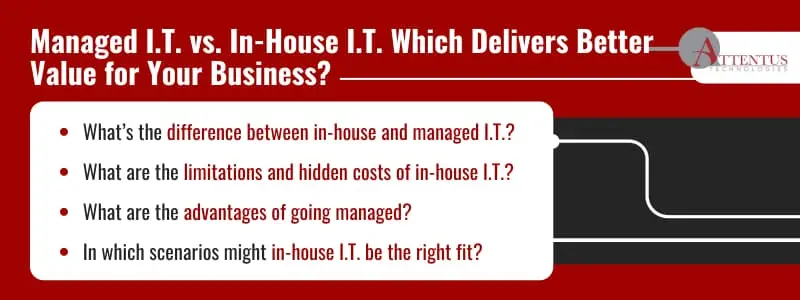Outsourcing I.T. now reduces costs by up to 40%. Is it time to finally make the switch to managed I.T. services?

Is your current I.T. support strategy delivering results, or just draining your budget?
SMBs today lose an average of $55,000 per year due to I.T. downtime, and IBM reports that a single breach costs about $4.88 million.
Robust capabilities to keep operations smooth and secure have become non-negotiable. 65% of organizations are turning to managed services to bridge costs and security gaps, according to Gartner’s 2024 Market Guide, and these forward-thinking organizations experience up to 40% lower costs.
That’s where the right partner makes all the difference.
For more than 20 years, Attentus Technologies has helped SMBs turn I.T. into a competitive advantage through proactive support, seamless operations, and strategic guidance.
Our vCIOs go beyond the help desk to advise on budgeting, compliance, and aligning tech with growth goals, so every dollar you spend actually moves your business forward. A personalized cost analysis from Attentus can show you exactly what’s being left on the table.
Before deciding how to support your technology, here are some crucial details about managed I.T. vs. in-house I.T.
The Differences Between Managed I.T. vs. In-House I.T.
Managed I.T. services mean outsourcing to a third-party provider for strategic leadership, cybersecurity, and 24/7 monitoring. Your partner becomes an extension of your team and proactively manages your technology to prevent breaches and maximize your investment’s value.
Conversely, with in-house I.T., internal employees manage support, infrastructure, and all technology projects within your organization. This approach has a place in specific contexts, but it can introduce scalability, cost predictability, and expertise gaps for SMBs.
The Advantage of Going Managed
What strategic advantages do you gain by I.T. outsourcing?
First, it lets you flip the script on the break-fix model and stay proactive. Your MSP deploys advanced monitoring, and incident response tools, and technologies to prevent downtime, data breaches, and other events from impacting operations and productivity. Businesses that switch to managed services cut downtime by up to 50%, per Forrester’s Total Economic Impact report.
Second, it keeps your costs predictable. MSPs typically charge a flat, comprehensive monthly fee. As a result, there are no overtime bills or emergency fees and you know precisely where your I.T. budget stands each month.
Finally, going with managed provides access to an entire team of specialists. You tap into a pool of experts in different fields, including cloud architects, security analysts, compliance advisors, network engineers, vCIOs (virtual Chief Information Officers), and more, iInstead of relying on one or two in-house generalists, you tap into a pool of experts in different fields, including cloud architects, security analysts, compliance advisors, network engineers, vCIOs (virtual Chief Information Officers), and more. This breadth of expertise means problems get resolved faster (and correctly) by a true subject-matter expert.
Find your ideal I.T. partner with our MSP Buyer’s Guide.
The Hidden Costs and Limitations of In-House I.T.
So what’s the actual cost of in-house I.T.?
There’s the money spent on infrastructure, like software licenses and equipment.These expenses increase considerably as you grow.
Next up, the cost of hiring. Skilled I.T. professionals are becoming tough to find in today’s dwindling talent pool and often come at a premium. Median annual wages for I.T. professionals are now $105,990, according to the U.S. Bureau of Labor Statistics (BLS), and that’s before factoring in the costs of ongoing training and benefits.
And then there are skill limitations. Here are a few questions to consider:
- Can your one or two technicians cover compliance, cloud, cybersecurity, and VoIP at the same time?
- Won’t issues take longer to resolve?
- Won’t you be setting up your in-house I.T. for burnout?
Lastly, let’s say you assemble a reliable team. Will you be able to keep them for the next five to 10 years? For context, in-house tech teams experience a 20% to 25% annual turnover rate, according to FirstPRO.
Put simply, in-house I.T. isn’t a sustainable long-term strategy for your SMB.
Cost Analysis: Managed I.T. vs. In-House I.T.
Let’s do a quick cost analysis of managed I.T. vs in-house I.T. In-house I.T. costs include:
- Salary: $105,990 annually for experienced I.T. personnel and up to $171,200 for managers, plus benefits.
- Hardware and software licenses: You’ll spend thousands on monitoring software, remote support tools, security software, not to mention the cost of purchasing and maintaining servers, networking gear, and so on.
- Hiring and turnover costs: If your I.T. personnel leaves, replacing them will cost you between $4,700 and four times their salary, according to the Society for Human Resource Management (SHRM).
- Downtime and productivity loss: If an understaffed I.T. team can’t proactively prevent outages, the business can lose $55,000 annually from even moderate downtime. Plus, employees who are waiting on tech fixes are not serving customers.
Now compare this with managed I.T. services costs:
An MSP will charge a flat monthly rate. That fee covers I.T. support, monitoring, security, data backups, and strategic guidance. Let’s say an MSP charges $150 per user per month for an organization of 50 people. That’s $7,500 per month or $90,000 per year.
| In-house I.T. | Managed I.T. | |
| Salary | $105,990 to $171,200, plus benefits | Included in a flat monthly fee |
| Hardware and Software Licenses | Thousands of dollars | Included in a flat monthly fee |
| Hiring and Turnover Costs | Between $4,700 and up to four times an employee’s salary | Zero |
| Downtime and Productivity Loss | $55,000 annually | Almost Zero |
In summary, the key benefits of managed I.T. services for SMBs include:
- Proactive support
- Predictable costs
- Full-spectrum expertise
- Lower downtime
- Stronger security posture
Is there still a case for in-house I.T.?
When In-House I.T. Might Be a Fit
An in-house team may make sense for large organizations with:
- Proprietary internal systems
- Complex, integrated operations
- High internal I.T. maturity and leadership
Even then, some enterprises may adopt a co-managed I.T. approach and keep an internal team for core functions while outsourcing certain services to MSPs (like security monitoring or cloud infrastructure management).
What’s Right for You?
Ultimately, the managed I.T. vs in-house I.T. debate comes down to a business’s size, strategy, and values. SMBs with 20 to 150 employees gain cost savings, better outcomes, and less risk by partnering with a managed provider. It’s not about cutting corners, but rather investing in technology more efficiently to support operations and growth initiatives.
This brings us to one final question: Out of all potential MSPs, why choose Attentus Technologies?
For more than 20 years, Attentus Managed Services has helped SMBs simplify I.T. and turn it into a competitive advantage, not a cost driver. Our proactive approach ensures your technology works seamlessly in the background to support every growth initiative. Further, our vCIOs provide strategic guidance about budgeting, compliance, and business-I.T. alignment to fast-track your success.
Get a personalized I.T. cost analysis from Attentus to determine if your current setup leaves value (and dollars) on the table.
